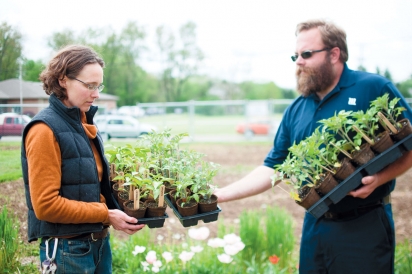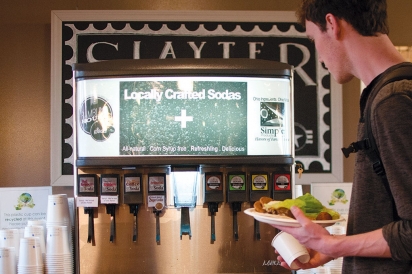Cafeterias Challenge the Status-Quo Offering Local and Seasonal From-Scratch Cooking
Farm to Institution
A plastic tray filled with gelatinous gravy slathered over previously frozen unidentifiable vegetables and rubbery meat. This was cafeteria eating in my youth. Tray after tray looked the same: Grayish, questionable contents reheated by well-meaning, yet disconnected, cooks.
On a recent visit to Denison University in Granville, my 1980s Orwellian view of cafeteria food was shattered. At Denison, a leader in the institutional locavore revolution, the university’s food service program is challenging the status quo by offering local and seasonal from-scratch cooking.
In the age of large-scale everything—agriculture, processing, packaging, portion sizes and waistlines—Denison and similar institutions are proving that sourcing smartly from small, regional producers can pack a big economic punch, contribute to healthy menus and support significant stabilization and growth in the local food landscape.
Getting Local Foods into Schools
According to the U.S. Department of Agriculture’s most recent Farm to School Census, 190 school districts in Ohio, representing 800 schools and more than 400,000 students, reported that they participated in farm to school activities during the 2013–2014 academic year. This amount represented more than $16 million dollars invested in local food systems in Ohio.
Farm to school purchasing supports regional economic systems. It also provides fresh, nutritious food and is often accompanied by a curriculum to help children understand where their food comes from and how nutrition choices impact health, economies and the environment.
In southeastern Ohio, Rural Action, a membership-based community development organization, is partnering with Hocking College’s culinary program to prepare food purchased from the Chesterfield Produce Auction for sale to school districts in the region. Hocking College students in the culinary arts program perfect their knife, blanching and packaging skills in a practical way to benefit the region’s children.
“In southeastern Ohio most farms are small. Through the produce auction and our partnership with Hocking College we have worked to develop a model that helps farmers scale to an institutional level,” Tom Redfern, director of sustainable agriculture and forestry at Rural Action, explains.
Today, school kitchens aren’t always equipped to process fresh foods. Hocking College was purchasing produce to teach processing but without an end use. Through the partnership established by Rural Action, schools that might not be equipped to process produce are now able to access local food that is ready for heating and serving. The initiative has received funding from the U.S. Department of Agriculture enabling Hocking College’s processing program to scale.
Reaching approximately 15,000 children since its inception in 2005, the program provides food to Federal Hocking Local Schools, Athens City Schools, Tri-County Career Center and Nelsonville-York City Schools, among others. Additionally, several university and hospital systems have purchased from the program at different points in its history.
At the university level, through its 31,000 meals served weekly, Denison University gives local food a spotlight. The university contracts to Bon Appétit Management Company for its dining services. Bon Appétit is known as a pioneer in the food industry for its humane, socially and environmentally responsible sourcing practices. The company is committed to sourcing at least 20% of its food from local farmers and artisans working within 150 miles of each café.
S.K. Piper, a Bon Appétit employee, is based at Denison University where she serves as the food service program’s sustainability manager, a position at Denison that was the first of its kind.
“Bon Appétit’s local food initiative—Farm to Fork—started in 1999. We pride ourselves on the fact that we have been committed to local, sustainable sourcing since before it was hip,” says Piper. The company’s local food definition is more than just geographic, she explains. Vendors must be owner-operated and there is an income cap to participate, which ensures that they are supporting small family businesses that contribute to a just food system.
According to Jeremy King, the coordinator of overall sustainability initiatives for the university, Denison is working towards 75% locally and responsibly sourced food in its dining halls.
“Our latest calculations show that 39% of our food spend fits this requirement,” Jeremy says. “In 2010, we were at 15%. We have been able to get to 39% without increasing costs to students. Shifting to responsible sourcing isn’t breaking the bank.”
The university contributes this success to several factors: Chef-driven from-scratch kitchens, adaptable menus based on seasonal availability and one-sided contracts with some of Denison’s nearly 40 local producers.
“The contracts say that we will buy a certain product, at an agreed upon price, for as long as the producer has that product available,” Piper explains. With a concrete financial commitment from the university, the contracts have enabled some producers to grow in scale to meet Denison’s need without taking unnecessary risk.
Bill VanScoy of VanScoy Farms provides produce to Denison year-round from his 138-acre farm located in Hardin County. “The contract has been great as it’s been a tool that we’ve used to lock in some of the variable costs that come with farming,” he says.
Local sourcing also has the potential to provide a pathway to increased food safety for participating institutions. “We harvest, grow and deliver our food,” Bill says. Food safety recalls often stem from issues that did not originate on farms but in packing and storage facilities or during transportation. “When food travels 3,000 miles there’s a lot of things that can go wrong,” Bill remarks.
Healing Health and Economies
“Improve the health of those we serve” is the governing mission of the Ohio-Health system. OhioHealth Marion General Hospital views local food purchasing as advancing the health of the hospital’s patients and visitors and improving the region’s economy.
“There has been a slow but growing interest in local food sourcing in healthcare,” says Niles Gebele, director of nutrition and environmental systems at the hospital. “There is apprehension because of logistics and consistency. To do ‘local,’ it takes time to develop the program and work with farmers.”
The hospital has contracted with a Central Ohio food distributor to purchase directly from Ohio farms. They have committed to sourcing cucumbers, blueberries, strawberries, cilantro and tomatoes, among other things, from local farms when in season with the goal of expanding their locally sourced portfolio.
“As an industry, there is nothing but the opportunity for local sourcing to grow especially as the logistics of buying locally become easier,” Niles says.
Licking Memorial Health Systems has also embraced local for both the health of the community and for the region’s economic prosperity.
Brian Merritt, who studied at Johnson and Wales Culinary School and previously worked at The Granville Inn, oversees the food program at the hospital, which serves approximately 750 meals a day at its two café locations, coffee shop, and to patients in the hospital system. The hospital also has a significant catering presence.
Brian’s operation is unique in the fact that it is self-operated. Though the system supplements local purchasing with orders from a national distributor, it does not have a contract and is not committed to one supplier. The hospital purchases dairy products for its coffee shop from Snowville Creamery. Its meat supplier is based out of Cleveland and sources from Ohio farms. Seventy-five percent of its disposable products are compostable and come from Going Green Services, another Ohio company. When possible, the program likes to buy products with an OhioProud label.
“One of the more challenging things that businesses run into are vendor certifications and going through the procurement hoops,” Brian says. “We don’t run into those issues because the administration here is so supportive and wants us to have a self-operated culinary focus. As long as a producer can provide basic vendor information we can source from them.”
Brian also has the benefit of working with a purchasing coordinator for the hospital’s food service program. “It will always require more work to source locally,” he says. “In our case, we have been able to do it due the fact that we have a person who works solely on sourcing.” As an official partner of the Licking County Local Foods Council, Brian and his team recognize the power that they have to effect real change due to the extensive volume that the hospital can commit to purchasing from regional producers.
The hospital also has a one-acre production garden. Now, three years in, the garden has seen significant growth and provides salad bar toppings for the hospital’s cafés and catering program.
Be Part of the Movement
With myriad layers of procurement hoops to jump through, establishing relationship with institutions can seem overwhelming for the already busy farmer or artisan. Approaching the task with clear, regular communication is key, says Laura Kington from OSU Extension’s Farm to School program.
“Schools prefer consistent quantity, quality, price and delivery from producers. They also need to plan their menus in advance. If you are approaching a school district to sell, be ready to provide a seasonality chart and a listing of your products and prices,” Laura explains.
OSU Extension will offer a series of workshops in October focused on bringing farmers and schools together. To learn more, visit farmtoschool.osu.edu.
Piper recommends that producers “be persistent, call or show up in person around 2 or 3pm, and bring a sample.” She also says to do your homework and find out who the decision maker is at an organization.
Speaking to institutions who wish to source more locally, both Piper and Bill reflect on the need to rid the process of administrative hurdles. Bill has seen increased interest from institutions in sourcing from his farm, however, several of the food service programs that he has spoken with remain uncommitted due to procurement obstacles.
“The activist in me questions why producers have to jump through so many hoops at some of our neighboring institutions. A number of the barriers seem to be just that, barriers, and do not seem to have any practical reason,” Piper reflects.
When a commitment to local sourcing is made, Denison University has found relationships easier to manage if standing orders with producers are established. “My yogurt provider knows that they will drop buckets at our dining halls every week and I will only call them if the order needs to be changed,” Piper says.
Finally, a commitment to from-scratch cooking has enabled several of the institutions profiled here to source more frequently from local providers.
“We have to be willing and able to eat the food we grow locally,” notes Erin Harvey, who operates a market garden and plant nursery in Lancaster called The Kale Yard. Erin served as a consultant to Licking Memorial Health Systems on their garden project and will provide the hospital with many of the plant starts for this year’s production.
“This means washing, processing and cooking whole foods. Our kitchens, menus and schedules are not necessarily set up for this process anymore, making it an impressive commitment for an institution to source locally,” Erin reflects.










